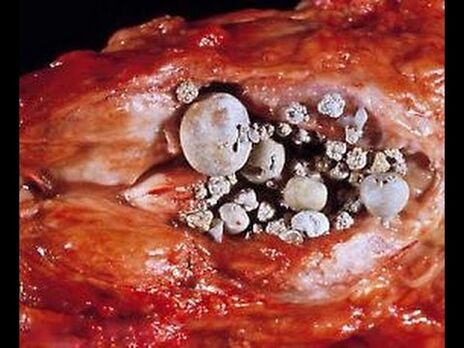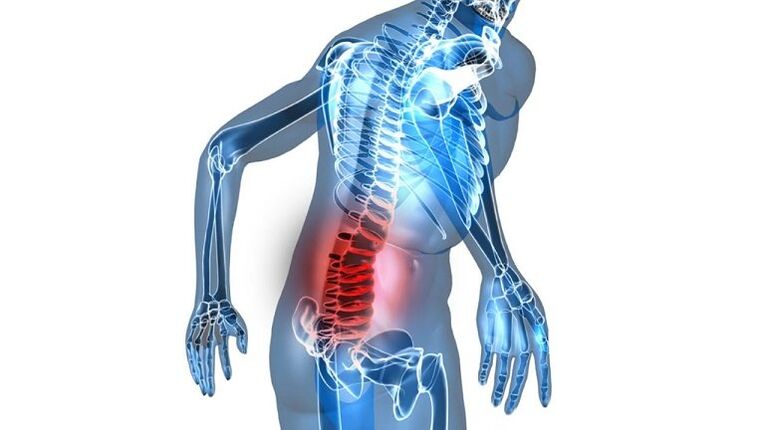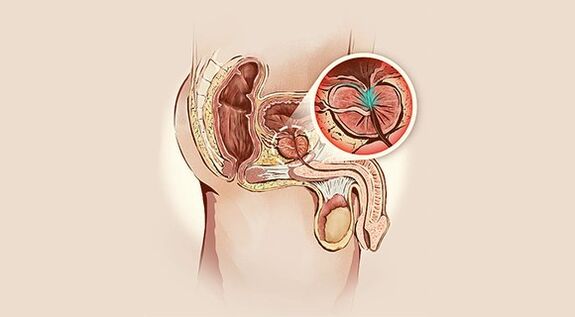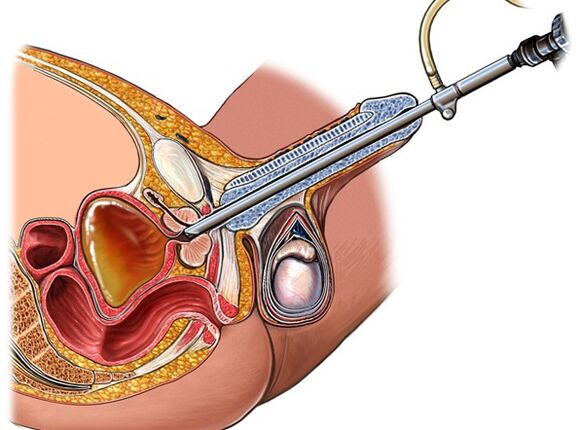Prostate gland disease is one of the most common and dangerous in men over 40 years of age. At first, patients may not be aware of the problem, but over time, the symptoms make themselves felt. If you do not see a doctor on time, prostatitis becomes chronic and complications may arise. Depending on the severity, cause and nature of the course, different types of prostatitis are distinguished.
Types of prostatitis according to its form:
- acute;
- chronic;
- latent.
What is prostatitis due to the occurrence of:
- herpetic;
- bacteria;
- count;
- stunted;
- infectious;
- purulent;
- chlamydia;
- fungus;
- stomachache
- fibrous.
Welding
Faced with unpleasant diseases of the genitourinary system such as inflammation of the prostate gland, many men wonder why they suffer from prostatitis.
Understanding the etiology of the disease helps in accurate diagnosis and effective prevention.
With the form of flow
According to the form of the course, prostatitis is divided into acute, chronic and latent, among which are distinguished catarrhal, follicular, parenchymal (purulent).
There are the following forms of the disease:
- With catarrhal prostatitis in the male body, there are urinary disturbances and discomfort in the genital area. This is the most common type of acute prostatitis.
- Follicular prostatitis is characterized by symptoms such as pain in the groin or anus, fever, and severe urinary disturbances (dysuria). In a more advanced form, when a patient delays a visit to the doctor, acute pain occurs during urination, and urinary retention occurs.
- Parenchymal prostatitis - an abscess with purulent contents formed in the body of the prostate gland. In this case, a fever occurs, a sharp pain appears frequently to urinate. The temperature rises to 39-40 ° C, the act of defecation becomes almost impossible.
Acute prostatitis
Acute prostatitis is a condition in which there is inflammation of the prostate gland, which occurs in a short time and is characterized by a variety of symptoms. Swelling of the glands occurs, which is provoked by the negative effects of pathogenic microflora. Disease -causing bacteria disrupt tissue integrity, causing permanent discomfort in the pelvic area, even at rest.
There are several main routes of infection to enter the prostate gland:
- with inflammation of the rectum - lymphogenous pathways;
- after infectious diseases - hematogenous;
- directly through the urethra - canal.
Excessive accumulation of content in the prostate gland creates excellent conditions for bacterial growth, which leads to various complications:
- abscess;
- BPH;
- prostate cancer;
- loss of potential;
- infertility.
The symptoms of prostatitis are so painful that the patient has to immediately see a doctor for help. If you don’t do this in a timely manner, prostatitis will turn into a chronic form, which is much harder to cure. Antibiotic therapy in combination with drugs that strengthen the immune system is effective against the disease.
Chronic prostatitis
Symptoms of chronic prostatitis are usually found against the background of congestion in the prostate gland, which is caused by an untreated disease in the acute form. It usually occurs in men over the age of 50 who do not seek help and have their own medication. A large number of them suffer complications due to concomitant diseases. In addition, at this age, not everyone is sexually active enough, as a result of which the secretions thicken and stagnate in the prostate, which leads to dysfunction. Disrupted sexual intercourse also causes fluid retention. According to modern research, about 40% of people who experience symptoms of chronic prostatitis experience erection problems.
Chronic prostatitis, as a rule, has mild symptoms that appear only during exacerbations. Patients notice dull pain in the groin area, which increases after physical exercise and at the end of the day. Often the pain radiates to the lower back, scrotum and perineum. Frequent urination is observed, especially at night, its flow is intermittent, flowing crookedly.
Sexual intercourse becomes shorter, incomplete erections are observed, sometimes there is pain in the glans penis. Infertility is commonly found in people with chronic prostatitis; impotence at this stage of the disease is almost non -existent. Sometimes there is a discoloration of the genitals, due to improper blood circulation, they turn purple.
Every symptom of prostatitis gets worse if left untreated. This condition is similar to the manifestations of acute illness. Weakness of the immune system, stress, neglect of diet, bad habits - all this leads to an increase and deterioration of the condition.
Often the chronic form leads to the appearance of symptoms of diseases such as cystitis, kidney disease, and adenomas. The risk of urolithiasis and the formation of malignant tumors is increased. Often, the pathological process is almost asymptomatic and is found inadvertently during laboratory tests associated with other diseases.
Because of the occurrence
There are many reasons that drive the development of prostatitis of infectious and non -infectious etiology, as well as predisposing factors. Because of its occurrence, the following types of prostatitis are distinguished:
- bacteria;
- count;
- stunted;
- infectious;
- purulent.
An inactive lifestyle, frequent hypothermia, infrequent sexual activity, disturbed sexual intercourse, smoking, alcohol abuse, stressful situations - all these conditions affect the stagnation of secretions in the prostate gland duct and in the ducts located next to it. Prostatitis is classified into several forms, depending on the causes of its occurrence.
Bacterial prostatitis
Bacterial prostatitis is caused by bacteria that enter the prostate gland in a variety of ways. It can be one type of bacteria or a group of them. This disease can be triggered by:
- fungus;
- gonococcus;
- Tongkat Koch;
- chlamydia;
- several types of bacteria at once.
The inflammatory process is most often associated with the penetration of bacteria into the prostate gland caused by venereal disease. Frequent sexual intercourse with frequent exchange of partners and without the use of protective methods leads to diseases such as gonorrhea, chlamydia, fungal infections. In addition, the development of pathology is facilitated by a decrease in immunity due to violations of the regime of work and rest. Bad habits, such as smoking, drinking alcohol, an inactive lifestyle, etc. , also reduce the body’s resilience.

The most obvious symptoms accompanying bacterial type prostatitis include burning, pain and whiteness during urination. The smell of urine is unpleasant. Common symptoms accompanied by poisoning are observed: dizziness, weakness, nausea, fever. Pain is observed during ejaculation, and sometimes there is blood. With chronic bacterial prostatitis, urination becomes more frequent, appearing yellowish or greenish from the penis.
Prostatitis calculus
With calculus prostatitis, stones form in the ducts of the prostate gland. This form of the disease is very complex and is accompanied by severe pain. Conglomerates have a variety of origins: phosphate, oxalate, with a predominance of calcium and protein.
There are two reasons for the occurrence of stones in the ducts: stagnation of the contents of the glands and excretion of urine into the prostate.
Stagnation is associated with a variety of factors that interfere with the normal outflow of secreted fluid. Prolonged sexual abstinence, hyperplasia, the presence of tumors that close the ducts, and an erratic lifestyle lead to stagnation of secretions and disorders of the vascular and lymphatic systems.

Urination is triggered by sphincter damage, which relaxes, and urine flows in and out. The presence of stones and sand in the bladder contributes to the expansion of stones in the prostate duct. They get in there with urine, settle and continue its growth, eventually reducing the outlet. Injury to the genital organs and surgical intervention can cause sphincter dysfunction.
Initially, countless forms of prostatitis are asymptomatic, as the stones grow, symptoms appear and increase. There is pain in the lower abdomen or in the scrotum, radiating to the buttocks and lower back. Pain during rest is not observed and only occurs during physical exercise, defecation and urination, as well as during sexual intercourse and when walking.
Large stones with sharp edges during its movement injure the ducts, which causes not only pain, but also the release of blood in the urine and ejaculation. Stone lesions are easily infected, and then calculus prostatitis will turn contagious.
After about a month, with calculus prostatitis, the work of the whole body is disrupted, a person feels unwell, suffers from insomnia, increased fatigue and irritability.
In advanced stages of calculus prostatitis, after a complete diagnostic examination, medication is prescribed and surgical treatment is performed to remove the conglomerate.
Congestive prostatitis
The appearance of obstructed prostatitis occurs due to a delay of secretion in the prostate gland. Often, such problems are observed in men who do not work, who are not involved in sports. As a result of hypodynamia, there is a violation of blood circulation in the pelvic organs, the prostate suffers from a lack of oxygen and nutrients, stagnation and inflammation occur. If nothing is done, the disease becomes chronic and causes discomfort.
Congestive prostatitis gives rise to an irregular sex life or its complete absence. In this case, men should release the glands independently of secretions, but not excessively, because regular masturbation can be harmful due to incomplete ejaculation. Many couples have found ways to prevent pregnancy as a sexual disorder. It also causes incomplete ejaculation and inflammation.

Sometimes hypothermia or varicose veins are a provoking factor. Structural abnormalities of the prostate gland can also cause stagnation. Too much heat in the pelvic area and persistent constipation adversely affects the production of secretions. Depending on the factors that provoke the disease, several types of congestive prostatitis are distinguished.
- Venous prostatitis. It occurs in people with varicose veins in the lower legs. In this disease, all the organs in the small pelvis are affected due to improper circulation.
- Congestive. It develops with partial emptying of the prostate gland. The overflow gradually causes stagnation.
- Chronicle. It develops when the wrong lifestyle has become a habit. If nothing is done to change the situation, the disease becomes chronic. It occurs more frequently in single men who are obese, as adults, when the anamnesis is burdened by a corresponding disease. At this stage, the prostate is often enlarged, which is easily determined during examination.
- Infectious. Joins pre -existing prostatitis when the infection enters the genitourinary system.
Symptoms of prostatitis are manifested due to difficulty urinating, pain in the groin, tension during defecation, and impaired sexual activity. As a result of these symptoms, with this type of prostatitis is blocked, poor health, irritability develops, ability to work decreases, and sleep is disturbed.
Infectious prostatitis
Microorganisms that can provoke the appearance of signs of acute prostatitis include Escherichia coli, Staphylococcus aureus, Proteus, Eltirococcus, Klebsiella. There are bacteria that are always present in the body, but in an inactive state they do not lead to the inflammatory process. During the penetration of the urethra into the mucous membrane of the prostate gland, the process of expansion and reproduction of microorganisms begins, as a result of which inflammation develops. Unsuspecting and unprotected sex also allows harmful bacteria to enter the body.
Typical symptoms are pain in the scrotum, perineum, lower abdomen, lower back, pain and a burning sensation in the small pelvis. Difficulty urinating, acute urinary retention occurs. In addition to the symptoms listed along with the type of infectious prostatitis, constipation, whiteness of the urethra, hemospermia and pain during ejaculation may occur.
It is a dangerous disease that, even in its early stages, can provoke infection of sexual partners, leading to generalized blood poisoning or the development of pyelonephritis and cystitis.
Purulent prostatitis
Purulent prostatitis usually develops when a bacterial infection enters the prostate. The disease occurs in four stages.
- Catarrhal. It develops after suffering from acute respiratory viral infections, tonsillitis, influenza. Purulent contents are found in urine. There is a burning sensation when the bladder is empty. The patient noted a decrease in potency. The process that accompanies this type of prostatitis involves the surface tissue of the prostate.
- Focus. The process extends to the glandular tissue. Ducts swell, outflow is disrupted. The gland increases in size due to the accumulation of pus in it, which is excreted in the urine. Body temperature rises.
- Parenchymal. Connective tissue is involved in the process, the edema becomes larger, the temperature can reach 40 ° C. Pain in the anus haunts, a false urge to defecate is felt.
- Excessive. The most dangerous form of prostatitis. The temperature was very confusing, there was a lot of pus and intolerable pain. This stage can be complicated by peritonitis and fraught with death.
Purulent prostatitis can be complicated by symptoms and diseases such as paraproctitis, paracystitis, abscesses, sepsis. Typically, this pathology is treated surgically and involves removal of the purulent sac.
Diagnostics
The diagnosis of this type of prostatitis is not so difficult and begins with the collection of anamnesis, which helps to understand the picture of the disease more accurately. Then an examination of the rectum is performed, in which the size of the gland is determined, the nature of the pain is determined, the presence of edema and seals are revealed.
To make an accurate diagnosis, laboratory tests are prescribed:
- Urine analysis;
- urine culture with sensitivity test to AB;
- general blood analysis;
- analysis of prostate secretion;
- blood chemistry;
- rectal examination.
Additional diagnostics include instrumental research methods. First of all, ultrasound is performed, if necessary, MRI and additional TRUS are prescribed. Recently, a new method of PET inspection has emerged, it is considered the most informative.
Treating inflammation
Urologists treat all types of prostatitis. Traditional methods are good, but only together with a medical prescription and with the permission of the attending physician.
First you need to know the cause of the disease, and only after that you can carry out post-symptomatic treatment.
- Active antibiotic therapy helps cure prostatitis. Parenteral antibiotics are most effective.
- With significant pain syndrome, painkillers and diuretics are indicated.
- For constipation, laxatives are prescribed.
- With severe pain and difficulty urinating, novocaine blockade was placed.
- A course of vitamin therapy and immunocorrector is indicated.
- Need to adhere to a special diet that does not include spicy, salty, smoked dishes.
- Bed rest is set.
From the local procedure, a sitz bath with water is indicated, the temperature of which is two degrees higher than the body temperature. Enemas are made with anti-inflammatory herbal ingredients with the addition of 1%anesthetic, while the contents are slowly injected into the intestine and left there for as long as the patient can hold it.
Physiotherapy treatment also has a beneficial effect on the restoration of prostate function. Prostate massage with acute prostatitis is prohibited, but in chronic form is recommended. To restore metabolism, normal blood circulation and relieve edema, UHF and microwaves are prescribed.
With prolonged urinary retention, a catheter is inserted. In some stages of the development of the disease, surgical treatment is indicated to open the purulent sac with the installation of a drainage channel.
Treatment of acute prostatitis takes from a few weeks to a month. Good results are usually observed. If the disease becomes more complicated or has entered a chronic stage, the process will be difficult, time consuming and may require several months.
During treatment, restrictions on sexual activity and the use of personal protective equipment were indicated.
Medical physiotherapy tools help cure prostatitis. It effectively relieves the symptoms of prostatitis, is able to restore reduced sexual activity, relieves pain, relieves swelling and inflammation. This tool can be used at home for the treatment and prevention of diseases of the pelvic organs.
This tool will relieve muscle tension, increase sperm production, strengthen blood vessels and prevent the possible development of other diseases in the small pelvis. This device, which can treat prostatitis in men, is easy to use, equipped with a heating and vibration mode regulator, and is powered by a network. The compact size allows the device to be used in any situation.
How to prevent the development of this disease?
Prevention of various types of prostatitis, like other diseases, is a healthy lifestyle, no bad habits and a balanced diet. If you have been diagnosed with prostatitis, exercise should not be neglected. For any inflammation that arises, you should see a doctor immediately to eliminate the cause and prevent the infection from entering other organs.

You have to live a decent lifestyle, have sex with a regular partner. It is important not to forget about personal hygiene of the genitals and not to neglect regular preventive examinations by urologists. If a man knows what prostatitis is, and at the same time leads a passive lifestyle, exercises should be done to prevent the appearance of congestion in the small pelvis.
Let's summarize
Depending on the cause and characteristics of the course, types of acute and chronic prostatitis are diagnosed. Chronic pelvic pain syndrome belongs to a separate group. Acute prostatitis is characterized by clinical manifestations such as chills, fever and pain. The chronic form may not appear in any way or have a mild picture: urinary incontinence, pain in the pelvic area, which when complications develop, can lead to impotence and loss of fertility.

Acute prostatitis develops suddenly and is easily diagnosed. In contrast, chronic prostatitis occurs in waves, periods of remission and alternating exacerbations. In chronic processes, the identification of pathogenic microbes can cause certain difficulties. The focus of infection arising in the genitourinary system gives rise to complications in the form of diseases of the organs that are anatomically adjacent to the prostate gland. Depending on which prostatitis is diagnosed, urologists prescribe different treatment regimens.






























